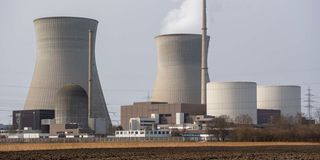Power to the people: Kenya looks to nuclear energy

The nuclear powerplant Gundremmingen is pictured in Gundremmingen, southern Germany on February 26, 2021. - The Bavarian village of Gundremmingen is still proud of its nuclear power plant, whose coat of arms bears a golden atom. But a page will be turned with the upcoming closure of this facility to accompany Germany in its energy revolution. (Photo by LENNART PREISS / AFP)
What you need to know:
- Kenya generates the majority of its power from geothermal sources, with wind and solar energy used in remote areas
- Kenya aims to transition to green power by 2030, but diesel plants remain the most polluting sources of power. Nuclear power is being considered as a cheaper alternative.
On July, I had the opportunity to join a media team that accompanied Energy CS Davis Chirchir to different power production sites in Nakuru and Baringo. Among the places we visited, the most notable was Menengai in Nakuru, where we toured a new geothermal power plant.
On August 4, Sosian Energy, a private power provider, injected 35MW into the national grid. Although this only accounted for 3.5 per cent of the total geothermal power produced, it was a significant achievement for Kenya as it moved up to the sixth position in geothermal power production globally, surpassing Mexico. Moreover, Kenya hit a milestone of generating over 1,000mw of geothermal power that day as hydropower production was low due to low water level in the dams. Geothermal energy has shielded Kenya from the impacts of climate change on power production as it uses renewable and cheap steam heated from within the earth, which is not affected by weather.
“Turkey is not out of our reach,” said the CS about the country that is at number four with a geothermal output of 1,682MW.
Kenya has become a significant player in the geothermal energy sector after pioneering renewable energy in the 1960s. But despite impressive milestones, electricity prices remain high due to reliance on fossil fuels and low water levels affecting hydropower dams.
Kenya generates the majority of its power from geothermal sources, with wind and solar energy used in remote areas. Diesel-powered Coast Kipevu generators make electricity expensive. The Coast region is the second-largest consumer of electricity, with a high demand for power due to new industries. Kenya aims to transition to green power by 2030, but diesel plants remain the most polluting sources of power. Nuclear power is being considered as a cheaper alternative. The cost of diesel plants ranges from Sh24 to Sh33 per unit.
According to Erick Ohaga, director of Nuclear Energy Infrastructure Development (NUPEA), the Kenyan government decided to consider nuclear as a probable source of power because it is reliable, clean and cost-reflective.
“A nuclear plant can have a lifespan of 60 years that can be extended to about 80 years. After the cost of the powerplant has been recovered in the first 20 years, you have 60 years to provide energy and make money, which can be used for investment purposes,” he said.
The nuclear power and energy agency has chosen the Coast region as the most applicable site for a nuclear power plant.
“Nuclear power plants are usually located near large bodies of water and while Turkana and Nyanza were probable candidates, they were ruled out because of being prone to earthquakes. That left two probable sites in Kilifi and Kwale, with the former being the front-runner,” Mr Ohaga added.
Nuclear power plants are, however, costly and take long to build; with a reactor costing billions of dollars and more than eight years to build. To meet the goal of having the first nuclear power plant start producing power by 2036, Kenya is looking into a new technology that involves Small Modular Reactors (SMR), which are cheaper and take a shorter time to build. These are nuclear reactors that produce power below 300 MW. While normal reactors can cost over $20 billion to build, SMRs can cost a fraction of that at about $1 billion.
“SMR technology will fit in well with Kenya’s energy needs as our grid is small, generating about 3200 MW. It is advised that no single unit of electricity generator should be more than 10 per cent of the total system capacity so the best units that would optimally fit into our grid would be below 320 MW, making SMRs a good option. Because they come in modular units, increasing output by adding more units to an existing plant is easy. SMRs also do not require a lot of land with a plant that could produce 900MW taking up 34 acres of land,” said Winfred Ndubai, the head of strategy and planning at NUPEA.
She spoke in Accra, Ghana at a workshop organised by the State Department for African countries interested in SMR technology.
Ghana has a nuclear research reactor that has been chosen by the US as a centre of excellence in matters to do with nuclear. South Africa is the only African country that produces nuclear power while Egypt is building its first nuclear plants in a partnership with Russia.
Enobot Agboraw, executive secretary at African Commission On Nuclear Energy, believes that more countries in Africa will be using nuclear power in the next 20 years. Nuclear is low carbon and has an advantage over solar and wind, which is intermittent. Nuclear fuel has a high density with 1kg of uranium providing the same power as 90 tonnes of coal and in the long term it is the cheapest option once the capital investment is paid off.




